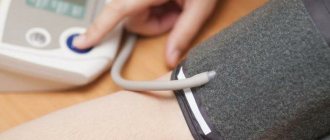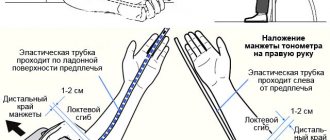Read in this article:
- Normal or pathological?
- What to do if the pressure on the right and left hands is different?
- Increase and decrease in pressure
- Reasons for the differences
- How to recognize blockage of blood vessels?
- How can the doctor help?
- How to avoid serious pathologies?
Everyone knows that blood pressure is measured on the arm. But if you put the blood pressure cuff on your left arm first and then on your right, the results may well be different.
What can affect and cause differences in performance?
There are several things that can cause differences in BP (blood pressure) readings. And not all of them are caused by diseases. The most common ones are discussed below.
Type of tonometer used
Devices for automatically measuring blood pressure are more convenient to use. The person simply needs to apply the cuff according to the instructions, press the start button and wait for the blood pressure readings to appear on the display.
But measurements are not always accurate, since if the cuff is applied incorrectly, the result will be distorted. The error may be 5–10 mmHg. Art. Mechanical blood pressure monitors are more accurate, but their use requires some skill.
Measurement time
The most accurate results can be obtained in the morning. Then - during the day - the body experiences various stresses, in particular, stress, physical activity, and eating, which can cause distortion of indicators.
To get the most accurate results, you need to measure blood pressure three times a day:
- in the morning immediately after waking up;
- until 14:00, but before lunch;
- just before bed.
If the indicators of each measurement on different hands are very different, then this is a reason to contact a therapist.
Violation of measurement rules
When measuring blood pressure, the person should sit straight, without leaning back in the chair. The hand should be positioned at the level of the heart so as not to provoke a false increase/decrease in readings. The cuff should not pinch your hand too much. Only by following all the recommendations can you obtain the most accurate blood pressure readings. The measurements can be repeated after waiting 10–15 minutes.
Important! The difference in pressure on the right and left hand is a natural condition. As a rule, blood pressure will be higher on the dominant arm. Permissible deviation – up to 10 mm Hg. Art. A figure of 10 or higher mm Hg is pathological. Art.
Fatigue and overwork
In a state of fatigue, blood pressure readings will be incorrect. If a serious difference is detected, a competent specialist will prescribe additional studies to identify the true cause of the pathology.
Possible reasons for the difference
There are three deviation options. This:
- On one hand the norm is normal, on the other there is an excess.
- On the left/right it is high, on the left/right it is even higher.
- On one hand - low, on the other - even lower.
The reasons why different hands have different blood pressure readings may be due to various factors. Most often this is:
Normal blood pressure during pregnancy
- Hypertonic disease. With this pathology, the patient experiences constantly elevated systolic (upper) pressure. Over time, the body “gets used” to this condition, but the heart pumps blood unevenly. As a result, this leads to differences in blood pressure in different arms.
- Stress. When under stress, the body releases adrenaline, norepinephrine and cortisol into the blood. In some cases, the inevitable increase in pressure occurs unevenly, which is reflected in the appearance of a difference.
- Anatomical features. For example, a person may have a different depth of the artery in their arms. In this case, the appearance of an error will be inevitable.
- Body features. Spasms of the muscles of the shoulder girdle or fibrotic changes occurring in the muscles may well provoke changes in blood pressure in the limb on the affected side.
- Vascular injury. Operations performed on blood vessels cause blood pressure disturbances.
- Increased density of the muscle tissue through which the subclavian artery passes.
- Arterial aneurysm. The condition requires urgent treatment, since its rupture can lead to death. If the aneurysm is located above the level of the cuff, then blood pressure readings on the affected limb will be lower than on the other.
- Thrombosis. The condition is very dangerous, since it can be complicated by the development of tissue ischemia against the background of poor blood supply and hidden necrosis.
- Formation of cholesterol plaque in the lumen of the subclavian artery (atherosclerosis). The pathology is accompanied by narrowing or complete blocking of the vessel. And this can also cause a significant difference in performance on different hands.
- Pregnancy.
The reasons for the difference in blood pressure are quite diverse, so you need to identify the specific one and take the necessary measures to eliminate it. Only in this case can we conclude whether this condition is normal or pathological.
What is the correct blood pressure if it is different on different hands? Doctors recommend focusing on a higher value and, to determine pressure, take measurements on the arm on which the tonometer determined a higher number.
Pulse rate
The normal pulse rate according to the WHO classification is 60-80 beats per second, although the very concept of “normal pulse” is, by and large, no more than a figure of speech, since each person’s pulse is individual. Moreover, the concept of normal may vary not only depending on the physiological state of a person, but also on the time of day. At night, the pulse can reach 38 beats per minute, which is a critically low point for daytime, after which activation of cardiac activity by a pacemaker is prescribed. In women, the pulse beats 6-8 beats faster than in men; during exercise, the pulse can reach up to 250 beats per minute. So, Kostya Tszyu’s pulse during training was 240 beats per minute, which was quite normal for him.
Dangerous symptoms
Various signs may indicate a pathological condition. The most common symptoms are:
- Weakness in the arm. A person cannot squeeze his hand tightly. As a rule, muscle weakness is noted on the side of the likely lesion.
- Poor circulation. The skin on the hand becomes bluish, and the limb itself becomes cold.
- Paresthesia. The condition consists of numbness of the fingertips and loss of sensation. This is a nonspecific sign of circulatory disorders. Paresthesia can also occur against the background of cervical osteochondrosis.
Important! Additionally, a person experiences symptoms typical of hyper- and hypotension.
There are a number of manifestations, the development of which the patient requires hospitalization. These include:
- causeless severe headache in the crown or back of the head;
- distortion of half the face or body is a symptom of a possible stroke;
- constant dizziness - can cause complete disorientation of a person in space;
- speech disorder;
- complete/partial paralysis;
- pain in the chest - when a heart attack develops, the pain is not severe, but constant, spreading to the epigastric region, causing difficulty breathing.
Emerging symptoms are assessed by a physician only as a whole. Depending on the severity of the manifestation, the patient may be hospitalized. The necessary assistance can be provided on the spot, but the person will be advised to visit a local pediatrician.
What can a significant difference between indicators indicate?
The pressure on the left and right hands should not differ too much. Permissible deviation – no higher than 10 mm Hg. Art. If the difference is more significant, then this is a sign of a disease. A difference of 10 units most often indicates atherosclerotic vascular damage.
If left untreated, a person may develop a stroke, myocardial infarction, or ischemic lesions. Basically, such a difference is diagnosed in people over 40 years of age, but sometimes it occurs earlier. A deviation of 15 units is a likely sign of acute heart failure, which in the future can lead to serious complications.
If a difference of 20 or more mm Hg is detected. Art. We can talk about complex violations. This is severe hypoxia of brain cells, complications of arterial hypertension, coronary heart disease, etc. A large difference in pressure between the right and left hand is accompanied by the development of characteristic symptoms. During this period, a person experiences:
- headache – sometimes very severe;
- attacks of nausea;
- dizziness;
- general weakness;
- breathing problems;
- coldness of hands and feet;
- darkening of the eyes.
The person becomes drowsy. There is a decrease in performance. It is possible that a feeling of tightness behind the sternum and a headache localized strictly in the occipital region may appear. If such symptoms often develop, it is necessary to consult a physician to identify the cause.
The difference in measurements on both hands does not exceed 10 mmHg. Art. is considered by doctors as an acceptable norm. But if blood pressure regularly deviates above this level, it is necessary to consult a specialist, since the cause of the condition may be heart and vascular diseases.
What should a healthy person's pulse be?
In the East, the pulse on the hand can not only determine diseases, but also predict fate. But is this indicator so important and how does the pulse change with age, and will it help to find out about Tourette’s syndrome? In infants, the heart rate is approximately twice as high as in adults, but by the age of 16-17 years, adolescents have the same heart rate as adults. What should it be like normally? “NG” decided to find out this from the famous cardiologist, leading researcher at the Republican Scientific and Practical Center “Cardiology”, Candidate of Medical Sciences Igor KOZLOV.
“If a person is in a lying position at rest, his pulse normally should not exceed 60-80 beats per minute,” explains the specialist. - This is the norm. In healthy people, each heartbeat is palpated by the pulse. But with atrial fibrillation and extrasystole, the heart rate and pulse rate may not coincide.
— What can a person’s pulse tell a specialist?
- About many things. In Chinese classical traditional medicine, up to 70 types of pulses are distinguished. In this country, diagnostics and assessment of health status are still carried out using the pulse. By the rhythm of the heart, you can determine whether a person has heart problems - extrasystole or atrial fibrillation. The next indicator is heart rate. If it is higher than normal at rest, this may indicate fever, thyrotoxicosis, anemia, heart failure, and some heart defects.
— What diseases cause a low pulse?
- With hypothyroidism - decreased function of the thyroid gland, typhoid fever, liver damage, such as obstructive jaundice, increased intracranial pressure as a result of traumatic brain injury, tumors or inflammatory processes in the meninges, with weakness of the sinus node.
— And when is the pulse of a healthy person the lowest?
- After a night's sleep, in the morning. If you count the pulse of a sleeping person at 4-5 o'clock in the morning, it will be slow. But during dreams, when a person moves his eyes quickly, his pulse can rise, as during physical activity, up to 110-120 beats per minute.
- How different is it at night and during the day?
- If you measure the pulse of a sleeping person every hour, and then do the same during the day, you can make sure that the night heart rate is noticeably lower than the daytime. And this is the norm. On average, the daytime heart rate is 1.2-1.4 times higher than the nighttime one. Moreover, on the left and right hands it will be the same both in frequency and in filling. If the pulse in different arms differs in filling, this may be a manifestation of various diseases (stenosis of the aortic mouth, stenosis of peripheral arteries, arteritis), when the flow of blood into one of the limbs is obstructed, while in the other it is normal.
— When is it not recommended to measure your pulse and why?
- You can always do this, but take into account what the person is currently doing. Naturally, measuring your pulse at the peak of physical activity will reveal tachycardia, which, however, is not a true reflection of the average daily heart rate. If the pulse does not respond to intense exercise at all, then it’s time to think about sick sinus syndrome. When body temperature rises, for example, during a feverish state, the pulse quickens by about 8-10 beats per degree increase. And after eating, it can also “frequently”, because blood circulation is activated, and for some, on the contrary, it can become less frequent, since the vagus nerve “wakes up”, for example, with duodenal ulcer. After drinking alcoholic beverages, the pulse usually increases, and in proportion to the amount of alcohol consumed. But this does not happen immediately, but 10 minutes after the dose is taken, reaching its maximum after 12 hours.
— Can the pulse quicken for no apparent reason?
- I think no. Pulse is a value that depends on human activity. Whether we are at rest or moving, whether we are in a horizontal or vertical position - all this is important. If a person was lying down and then gets up, then the pulse when moving to a vertical position increases by 8-12 beats per minute, and then decreases slightly. And this is also the norm. Regular physical training and physical labor lead to a natural decrease in resting heart rate. In the age range from 18 to 60 years, the heart rate depends not so much on age, but on the degree of physical activity and fitness of the body. But if in similar situations there is a persistent progressive change in heart rate (increase or decrease) for no apparent reason, then you need to consult a doctor.
— I have read more than once: the lower the pulse, the longer the life. Is it really?
- Not always. This statement belongs to biologists. They showed that the higher the pulse rate of an animal, the lower the species’ life expectancy. As for humans, such observations were also made. It was found that the average life expectancy in groups of patients with coronary heart disease whose pulse exceeds 80 beats per minute is lower than that of those who have it below 70. It was also noted that the more the disease progressed, the higher the frequency. the patient's pulse. And in healthy people, the results are as follows: the more physically trained the body is, the lower the heart rate. Bottom line: Reasonable exercise is essential for heart health.
Differences in blood pressure readings during pregnancy
During pregnancy, different blood pressure readings in the arms can be determined at all stages, but most often they are typical for the last trimester.
Different blood pressure readings in the arms of pregnant women most often occur in the later stages
Quite often the cause is an inflammatory process that affects the arteries and causes a narrowing of their lumen. If left untreated, the pathology will progress. The tissues will not receive the necessary nutrients and the required amount of oxygen. The latter circumstance ultimately leads to the development of severe fetal hypoxia.
How to recognize blockage of blood vessels?
Blockage of blood vessels, which does not allow blood to circulate normally, may well manifest itself in a decrease in pressure in one arm. In such situations:
- The brush loses strength;
- The fingers become pale and cold;
- Numbness appears;
- Blueness of the skin appears on the fingers or the entire hand.
When the pressure on the right hand decreases and at the same time dizziness and headaches, vomiting and nausea, difficulty speaking and distortion of the face, weakening of attention and memory, paralysis of the body on one side appear, this indicates problems with blood circulation in the brain. The fact is that nutrients to the brain and right arm come through arteries that start from the aorta in the form of one trunk.
Differences in blood pressure in the lower extremities
To diagnose certain diseases, your doctor may also measure blood pressure in your legs. There is a difference in blood pressure levels in the arms and legs, but it is not too large. In this case, the indicators in the lower extremities - if the person is healthy - will be higher than in the upper extremities.
The permissible threshold is 20 mmHg. Art. If the difference is greater (regardless of which side the excess is noted), this means that the patient may develop a narrowing of the lumen of the aorta or main arteries. Low blood pressure becomes a sign of pathology.
The cause of deviation from the norm may be a common cold. The condition is accompanied by an increase in body temperature and a disturbance in general well-being. A slight excess of the permissible threshold may occur after cosmetic wraps for the purpose of weight correction.
Bian-Qiao
The Eastern school of pulse diagnostics is associated with the name of the legendary Chinese physician Bian Qiao, who lived in the 6th century BC. According to legend, one day Bian Qiao was invited to the house of a mandarin whose daughter was ill. Diagnosis and treatment were complicated by the fact that the noble girl could not be touched. Bian Qiao found a way out of the situation. He asked to tie a long cord to the patient’s arm and give him the other end. The mandarin's servants decided to play a prank on the doctor and tied a cord to the dog's paw. Bian Qiao immediately said that the vibrations he felt were not the vibrations of a person, but of an animal, moreover, sick with worms. Realizing that it was difficult to deceive the doctor, the servants tied a cord to the hand of the mandarin’s daughter, and Bian Qiao immediately made a diagnosis from the pulsation of the rope.
Diagnostic tests
To identify the cause of the pathological difference in blood pressure, you need to consult a cardiologist. If necessary, the doctor will refer the patient to see a specialized specialist: a neurologist or endocrinologist.
To make a preliminary diagnosis, the doctor will interview the patient and clarify what complaints he has. It is necessary to measure blood pressure levels in both arms to confirm the presence of a difference in indicators.
To clarify the preliminary diagnosis, the following studies are carried out:
- ECG is necessary to assess the functioning of the heart.
- Blood biochemistry and testing for specific hormones. Of diagnostic interest is the level of the hormones T3, T4, TSH, cortisol, as well as specific substances of the pituitary gland.
- Angiography. Rarely prescribed.
- Dopplerography. The study allows you to evaluate the speed of blood flow.
- General blood test.
If necessary, other types of studies may be prescribed.
Treatment
Before carrying out any treatment, it is necessary to make sure that the difference between blood pressure readings in the arms is pathological. To do this, you need to take measurements on both limbs over several days and record the indicators in a diary. When contacting a doctor, you must show the results obtained.
If the specialist “doesn’t like the numbers,” he will prescribe diagnostic tests. After completing the examination, the patient will be prescribed treatment, if necessary. This may include:
- drugs that improve the condition of blood vessels;
- agents for the treatment of atherosclerosis and dissolution of existing cholesterol plaques;
- medications that reduce blood density;
- drugs for the treatment of hypertension, alleviation of symptoms of vegetative-vascular dystonia.
It is mandatory to prescribe physiotherapy and undergo a complex of exercise therapy. Therapeutic gymnastics improves the function of blood vessels in the upper girdle. If necessary, the patient undergoes surgical treatment. The indication is the identification of large blood clots, tumor formations and sclerotic changes that have occurred.
When prescribing treatment, the doctor takes into account in which direction - increase or decrease - the change in blood pressure occurs. When it decreases, medications are used that stimulate the functioning of organs and systems.
Reviewing your personal diet will help normalize blood pressure
Additionally, a review of the diet will be recommended. You will need to exclude fatty, salty and smoked foods/dishes from the menu. Because they not only worsen the digestion process, but also negatively affect the condition of blood vessels.
Prevention
To prevent the occurrence of diseases and conditions that cause a high difference in blood pressure in both arms, you must follow the following medical recommendations:
- you need to move actively, do exercises, but try not to overload your muscles;
- eat a nutritious and varied diet;
- give up bad habits in favor of a healthy lifestyle;
- promptly treat any diseases of the cardiovascular system, including hypo- and hypertension;
- you need to regularly visit your doctor to monitor the dynamics of changes in the condition and monitor the effectiveness of the treatment;
- independently monitor blood pressure readings, taking measurements in the morning and evening - if regular deviations are detected, you should consult a cardiologist.
Differences in blood pressure readings on different arms are quite common and in most cases are an acceptable norm. But if the deviation “allowed” by doctors is regularly exceeded by 10 mm Hg. Art. You must consult a doctor.
Pulsation of the world and man
Diagnosing health by pulse is the oldest method of health monitoring. Research on the relationship between pulse activity and human condition was carried out both in the East and in the West. The very first full-fledged work on pulse diagnostics known to Western civilization is the treatise by the Alexandrian physician of the Ptolemaic dynasty Herophilus of Chalcedon “Peri sphigmon pragmateias”. Herophilus believed that one could determine the state of health by the pulse, as well as “foresee the future.” The doctor compared different types of pulse with musical rhythms and introduced the concepts of systole and diastole. These terms, as well as the concept of “jumping pulse”, have been preserved in modern medicine. All famous physicians of antiquity, from Galen to Paracelsus, practiced pulse diagnostics. The very ancient perception of the world as a macrocosm, and man as a microcosm (the alchemical principle of similarity) indicated that rhythmic pulsations are one of the key principles of the world order, and therefore they should be studied in detail.









